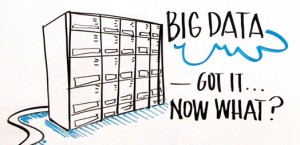It's true. "Big data" can be a problem and an opportunity. Many organizations have struggled to manage, much less profit from, the deluge.
In 2012, look for big data to spur demand for big data analytics. New developments in high-performance computing as well as increased demand for visualization and text analytics will drive markets, and industry leaders will look for new ways to expand analytics bandwidth. Read on for more detail on how I think these four areas will rock the world in 2012.
 High-Performance Analytics: Grid computing, in-database and in-memory analytics and other technologies can help organizations face their biggest data challenges. In one example, markdown optimization helped a major retailer pinpoint which products to discount and when, all the way down to SKUs at the store level. This combines complex estimation with optimization. The retailer’s whopping 3 terabytes of data used to take 30 hours to analyze; with in-memory distributed processing and high-performance analytics, that time was slashed to two hours. Now, over a weekend, models run with several iterations instead of one. Imagine what improving even one extra day of high-holiday sales can mean to a retail season. Watch for more high-performance computing solutions to hit the market soon.
High-Performance Analytics: Grid computing, in-database and in-memory analytics and other technologies can help organizations face their biggest data challenges. In one example, markdown optimization helped a major retailer pinpoint which products to discount and when, all the way down to SKUs at the store level. This combines complex estimation with optimization. The retailer’s whopping 3 terabytes of data used to take 30 hours to analyze; with in-memory distributed processing and high-performance analytics, that time was slashed to two hours. Now, over a weekend, models run with several iterations instead of one. Imagine what improving even one extra day of high-holiday sales can mean to a retail season. Watch for more high-performance computing solutions to hit the market soon.
Visualization: Hotter than ever before, visualization is invaluable for testing hypotheses. It saves business analysts precious time hunting for answers. The LA County Department of Social Services uses social network analysis from SAS to prevent fraud in the child welfare public assistance program. Visual representation of complex data quickly cued investigators in on fraud rings, saving taxpayers $31 million its first year in use.
Text Analytics: What about free-form text? Numerous attributes per transaction result in massive stores of unstructured data. Industry leaders must rely on text analytics to put text data to work—there’s no way to do that manually. Behind the scenes, warranty analysis has saved millions by identifying manufacturing issues buried in product complaints, health outbreaks are predicted – and mitigated – by text mining EMS logs, and retailers refine product offerings and respond instantly to customer issues by analyzing social media.
Education: With this burgeoning interest in analytics, the demand for talent increases – underscoring the importance of relationships between industry and academia. Let’s reform computer science education and graduate programs to include business applications of statistics and analytics that help students know not only how to capture and store data, but also how to use analytics to extract maximum value. Analytics-savvy graduates will be the ones who are first to succeed in our data-rich business world.
How will you use analytics in 2012? Do the four areas I mentioned affect your organization, or are you seeing other benefits from analytics?
